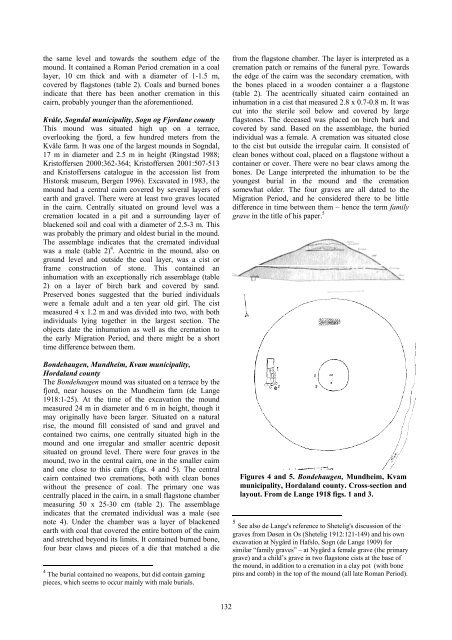The Materiality of Death - mikroarkeologi.se
The Materiality of Death - mikroarkeologi.se
The Materiality of Death - mikroarkeologi.se
Create successful ePaper yourself
Turn your PDF publications into a flip-book with our unique Google optimized e-Paper software.
the same level and towards the southern edge <strong>of</strong> the<br />
mound. It contained a Roman Period cremation in a coal<br />
layer, 10 cm thick and with a diameter <strong>of</strong> 1-1.5 m,<br />
covered by flagstones (table 2). Coals and burned bones<br />
indicate that there has been another cremation in this<br />
cairn, probably younger than the aforementioned.<br />
Kvåle, Sogndal municipality, Sogn og Fjordane county<br />
This mound was situated high up on a terrace,<br />
overlooking the fjord, a few hundred meters from the<br />
Kvåle farm. It was one <strong>of</strong> the largest mounds in Sogndal,<br />
17 m in diameter and 2.5 m in height (Ringstad 1988;<br />
Krist<strong>of</strong>fer<strong>se</strong>n 2000:362-364; Krist<strong>of</strong>fer<strong>se</strong>n 2001:507-513<br />
and Krist<strong>of</strong>fer<strong>se</strong>ns catalogue in the accession list from<br />
Historsk mu<strong>se</strong>um, Bergen 1996). Excavated in 1983, the<br />
mound had a central cairn covered by <strong>se</strong>veral layers <strong>of</strong><br />
earth and gravel. <strong>The</strong>re were at least two graves located<br />
in the cairn. Centrally situated on ground level was a<br />
cremation located in a pit and a surrounding layer <strong>of</strong><br />
blackened soil and coal with a diameter <strong>of</strong> 2.5-3 m. This<br />
was probably the primary and oldest burial in the mound.<br />
<strong>The</strong> as<strong>se</strong>mblage indicates that the cremated individual<br />
was a male (table 2) 4 . Acentric in the mound, also on<br />
ground level and outside the coal layer, was a cist or<br />
frame construction <strong>of</strong> stone. This contained an<br />
inhumation with an exceptionally rich as<strong>se</strong>mblage (table<br />
2) on a layer <strong>of</strong> birch bark and covered by sand.<br />
Pre<strong>se</strong>rved bones suggested that the buried individuals<br />
were a female adult and a ten year old girl. <strong>The</strong> cist<br />
measured 4 x 1.2 m and was divided into two, with both<br />
individuals lying together in the largest <strong>se</strong>ction. <strong>The</strong><br />
objects date the inhumation as well as the cremation to<br />
the early Migration Period, and there might be a short<br />
time difference between them.<br />
Bondehaugen, Mundheim, Kvam municipality,<br />
Hordaland county<br />
<strong>The</strong> Bondehaugen mound was situated on a terrace by the<br />
fjord, near hou<strong>se</strong>s on the Mundheim farm (de Lange<br />
1918:1-25). At the time <strong>of</strong> the excavation the mound<br />
measured 24 m in diameter and 6 m in height, though it<br />
may originally have been larger. Situated on a natural<br />
ri<strong>se</strong>, the mound fill consisted <strong>of</strong> sand and gravel and<br />
contained two cairns, one centrally situated high in the<br />
mound and one irregular and smaller acentric deposit<br />
situated on ground level. <strong>The</strong>re were four graves in the<br />
mound, two in the central cairn, one in the smaller cairn<br />
and one clo<strong>se</strong> to this cairn (figs. 4 and 5). <strong>The</strong> central<br />
cairn contained two cremations, both with clean bones<br />
without the pre<strong>se</strong>nce <strong>of</strong> coal. <strong>The</strong> primary one was<br />
centrally placed in the cairn, in a small flagstone chamber<br />
measuring 50 x 25-30 cm (table 2). <strong>The</strong> as<strong>se</strong>mblage<br />
indicates that the cremated individual was a male (<strong>se</strong>e<br />
note 4). Under the chamber was a layer <strong>of</strong> blackened<br />
earth with coal that covered the entire bottom <strong>of</strong> the cairn<br />
and stretched beyond its limits. It contained burned bone,<br />
four bear claws and pieces <strong>of</strong> a die that matched a die<br />
4 <strong>The</strong> burial contained no weapons, but did contain gaming<br />
pieces, which <strong>se</strong>ems to occur mainly with male burials.<br />
from the flagstone chamber. <strong>The</strong> layer is interpreted as a<br />
cremation patch or remains <strong>of</strong> the funeral pyre. Towards<br />
the edge <strong>of</strong> the cairn was the <strong>se</strong>condary cremation, with<br />
the bones placed in a wooden container a a flagstone<br />
(table 2). <strong>The</strong> acentrically situated cairn contained an<br />
inhumation in a cist that measured 2.8 x 0.7-0.8 m. It was<br />
cut into the sterile soil below and covered by large<br />
flagstones. <strong>The</strong> decea<strong>se</strong>d was placed on birch bark and<br />
covered by sand. Ba<strong>se</strong>d on the as<strong>se</strong>mblage, the buried<br />
individual was a female. A cremation was situated clo<strong>se</strong><br />
to the cist but outside the irregular cairn. It consisted <strong>of</strong><br />
clean bones without coal, placed on a flagstone without a<br />
container or cover. <strong>The</strong>re were no bear claws among the<br />
bones. De Lange interpreted the inhumation to be the<br />
youngest burial in the mound and the cremation<br />
somewhat older. <strong>The</strong> four graves are all dated to the<br />
Migration Period, and he considered there to be little<br />
difference in time between them – hence the term family<br />
grave in the title <strong>of</strong> his paper. 5<br />
Figures 4 and 5. Bondehaugen, Mundheim, Kvam<br />
municipality, Hordaland county. Cross-<strong>se</strong>ction and<br />
layout. From de Lange 1918 figs. 1 and 3.<br />
5 See also de Lange's reference to Shetelig's discussion <strong>of</strong> the<br />
graves from Dø<strong>se</strong>n in Os (Shetelig 1912:121-149) and his own<br />
excavation at Nygård in Hafslo, Sogn (de Lange 1909) for<br />
similar “family graves” – at Nygård a female grave (the primary<br />
grave) and a child’s grave in two flagstone cists at the ba<strong>se</strong> <strong>of</strong><br />
the mound, in addition to a cremation in a clay pot (with bone<br />
pins and comb) in the top <strong>of</strong> the mound (all late Roman Period).<br />
132
















